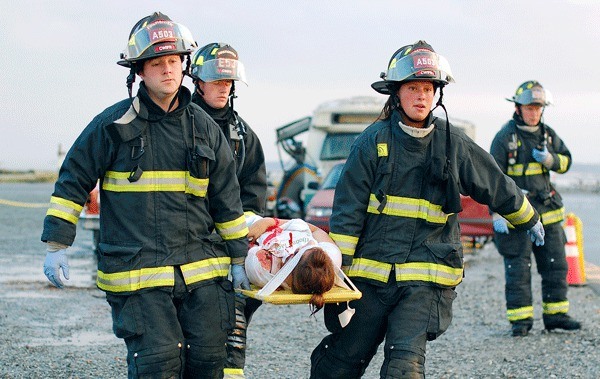A training exercise meant to test Whidbey Island emergency responders turned the parking lot at Keystone Harbor into a disaster area Monday evening.
Scattered throughout a concentration of twisted and burned out vehicles, people of all ages with fake but gruesome injuries cried out in mock pain. Mothers begged firefighters for the whereabouts of their children. The area was littered with the bodies of the maimed and dying.
It was all fake of course, the simulation of a ferry explosion meant to strain if not overwhelm Whidbey Island’s emergency response agencies, including Whidbey General Hospital. None of the approximately 20 “victims” that participated in the exercise were actually hurt, although they did a good job pretending to be.
Along with some coaching on how to act, each had their injuries made up by a professional makeup artist from Everett. While they ranged from minor burns to bloody compound bone fractures, each looked very real.
Some of the victims were looking forward to giving the performance of a lifetime.
“It’s going to be cool,” said 12-year-old Dominick Norberg, a few minutes before the exercise began.
Norberg was one of several Boy Scouts from Troop 4058 who volunteered for the training drill as a way to earn emergency preparedness merit badges.
The fake injuries and pitiful moans coming from the actor/victims made for an eerily realistic scene, which is just the way it was supposed to be, said Central Whidbey Fire and Rescue Chief Ed Hartin, director of Monday’s phony catastrophe. The more realistic it is, the more effective the training.
The purpose of the exercise was to give Whidbey Island responders a chance to train for a mega disaster, a situation in which the wounded outnumber the rescuers. The event is designed to strain their capacity and force all the various agencies to work cooperatively.
“They all have to fit together and manage well,” Hartin said.
A mock ferry explosion, in which a large number of victims are in a variety of life-threatening situations — the exercise included a water rescue — is an excellent, and very possible scenario, Hartin said. About 50 people from at least eight agencies participated in the event.
To create the disaster zone, eight old vehicles, including a burned out Island Transit bus, were corralled within a small area of the parking lot. Firefighters were tasked with not only systematically searching the vehicles for victims, but also evaluating, separating and treating them based on the severity of their injuries.
The exercise moved to Whidbey General Hospital with the transport of the victims. Like the firefighters, hospital staff were faced with a challenging hypothetical situation in which they lost the capacity to move patients to another hospital. Again, the idea was to overwhelm them with a large-scale event.
According to Hartin, the entire event lasted about three-and-a-half hours. An official debrief has yet to occur, but some lessons were obvious. While emergency responders demonstrated excellent task management and patient care skills, communication between all the various agencies could use some improvement. That wasn’t much of a surprise, said Hartin, considering the size and scale of the exercise.
“That’s almost always the case with these kind of events,” he said.
View Keystone Harbor disaster drill in a larger map



